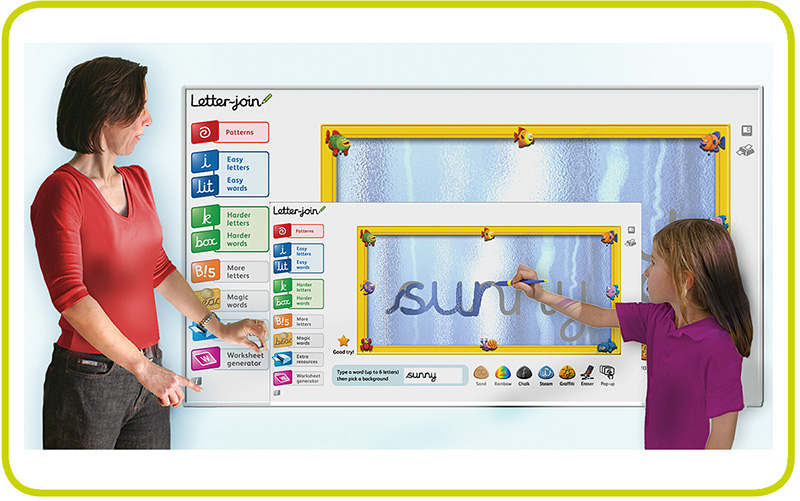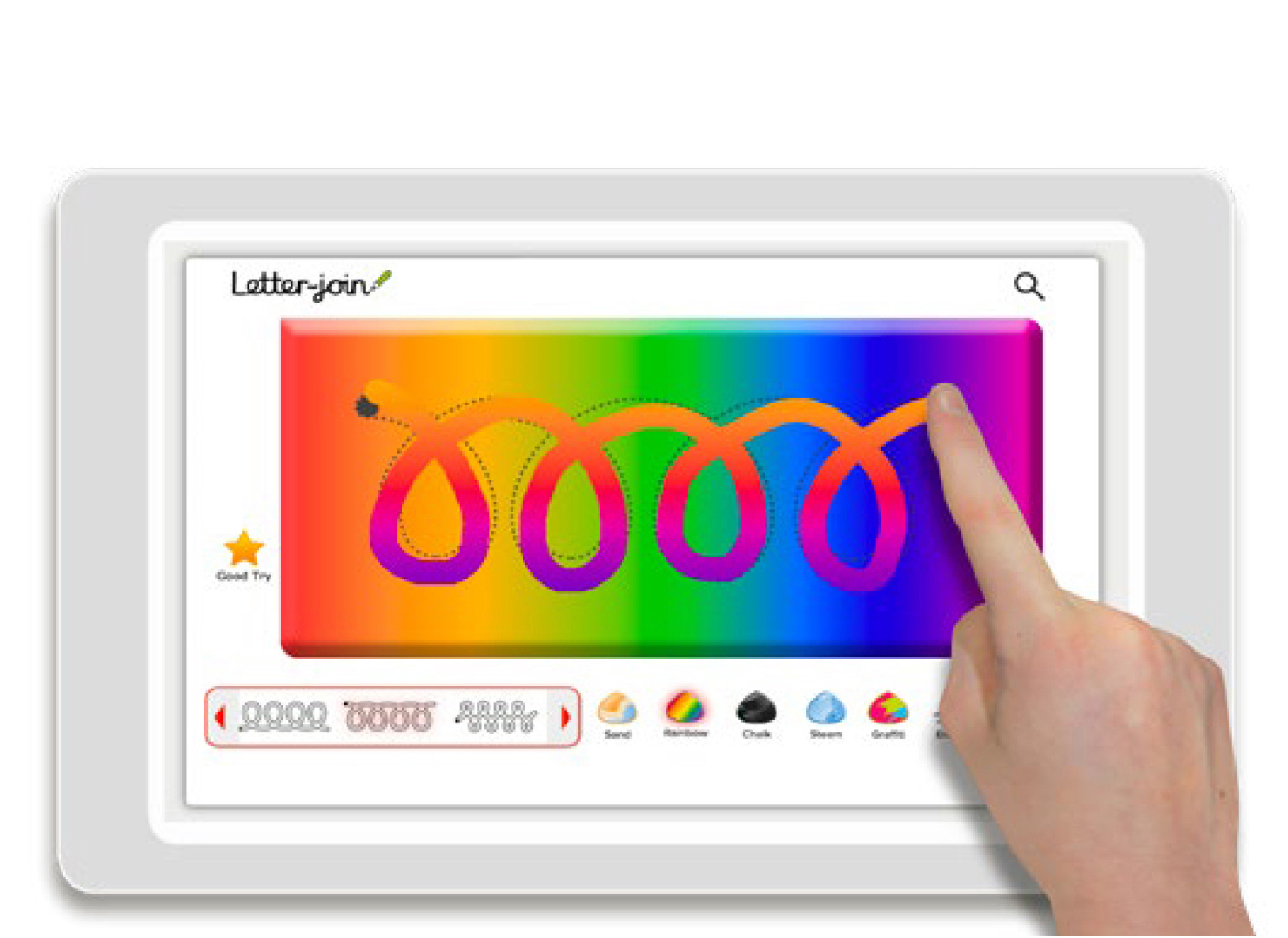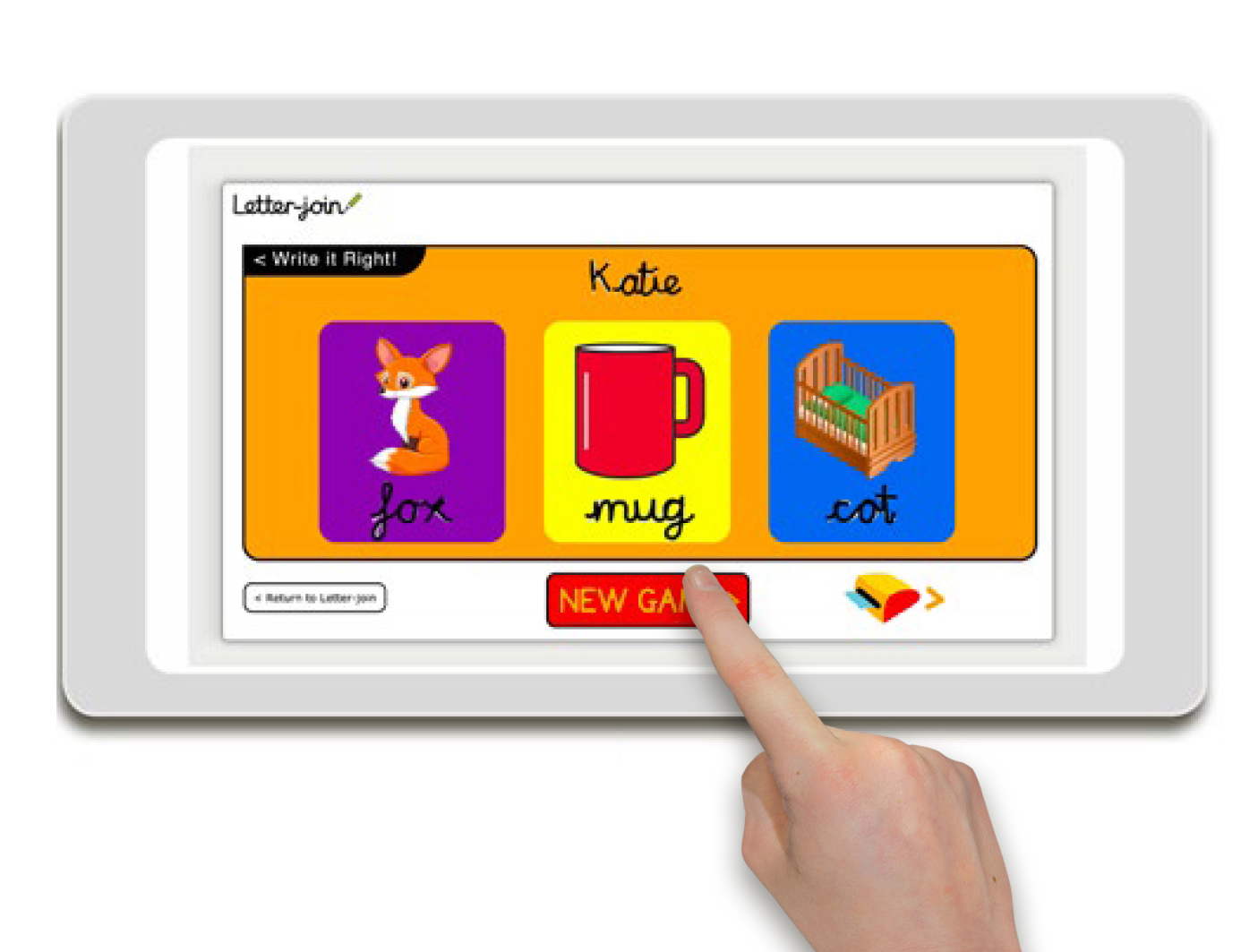
Letter-join offers a wealth of handwriting resources including interactive features for IWBs, PCs and tablets as well as worksheets that use your pre-selected letterforms. Letter-join's downloadable fonts for MS Word are included in school subscriptions as well as a series of Lesson Planners for all year groups.
Letter-join is ideally suited for displaying on IWBs for whole class teaching. The web site is easy to use with all resources easily accessible: animations, IWB tracing activities and access to all of the worksheets.


Letter-join includes animations of all the letters of the alphabet with a spoken commentary on how to write each letter. Patterns, letters and words can all be watched and traced on-screen. Magic Patterns allows children to trace pre-cursive patterns and fun shapes on a variety of ‘magic’ backgrounds and with Magic Words they can trace over their own words on different backgrounds on IWBs or tablets. Word Animator lets you input your own words, replay the video and trace over the words for IWB practice.
Handwriting Lesson Planners: Modules 1 to 7
To suit your school’s handwriting policy, Letter-join’s Lesson Planners offer two routes into teaching handwriting. Teachers can choose to start teaching handwriting with either printed or cursive letters in Early Years and Key Stage 1.
There are 7 modules in each section (print or cursive) which cover Early Years through to Year 6.
The Lesson Planners can be downloaded by subscribing schools by logging into a classroom account and choosing the 'Info' button.

Module 1 Print for teaching handwriting using the printed method. Resources supporting the printed font include all animations, lowercase letters and words, phonics, games and activities and KS1 worksheets.
Module 1 Cursive covers pre-cursive patterns and continuous cursive, lower case letters with or without lead-in lines. At the end of this module children should be able to form and join all lowercase letters.

Module 2 Print to Cursive for teaching how to correctly write capital letters, numbers, punctuation, and symbols, and uses of printed letters. Pre-cursive patterns and cursive letters are then introduced in preparation for Module 3 when children are required to start joining their handwriting.
Children will practise their fine and gross motor skills, learn how to sit correctly for handwriting using the tripod grip and will be introduced to the different letter families.

Module 3 Starting Cursive introduces children to cursive letters and how to join them. They will have regular practice in letter formation and joining their handwriting.

Module 4 contains 60 lessons to improve legibility, consistency and quality of handwriting.
It is targeted at Year 3 children in lower KS2 where pupils should be using joined handwriting throughout their independent writing.
It is designed to improve quality of handwriting through resources which link handwriting to other topics.

Module 5 focuses on using handwriting practice to support other subjects in the curriculum and, at the same time, builds on fluency and consistency.
Learners will continue to build on producing legible handwriting through the regular practice offered in this module’s lessons.

Module 6 continues to build on combining fluent handwriting with other subjects across the curriculum.
By the end of this module, children should be producing cursive writing automatically, enabling them to focus on the content of their work rather than the process of writing.

The aim of Module 7 is to ensure that handwriting is neatly presented and clear in readiness for KS2 SATs and is the expected standard of handwriting for Year 6.
Learners will consolidate the stamina and skills required to write at length, with accurate spelling and punctuation. They will develop more of a personal handwriting style as they write with automaticity and will learn to write at different speeds with different attention to neatness, depending on the task.

Designed for pupils in upper Key Stage 2 and above who require extra handwriting support.

Letter-join’s Handwriting Assessment Tracker Pack has been designed in line with National Curriculum targets for handwriting. It provides a complete scheme for assessing pupils’ progression in handwriting skills from Early Years to Year 6.

Included with every School Subscription is access to Letter-join for pupils at home. This is particularly good for new joiners where parents might be unfamiliar with cursive handwriting. A simple log-in allows pupils and their parents to access the child's classroom account of Letter-join on their PCs and tablets.
Staff can download the Letter-join fonts to create documents in MS Word. The fonts can also be used online for the Worksheet Generator, On-line Word Processor and Letter-join's Fun activities.
In the Resources section, relevant Early Years and KS1 worksheets are avaiable in all fonts, printed and cursive, joined and unjoined, but KS2 worksheets are only available with the joined fonts Letter-join Plus and Letter-join No-lead.
Letter-join Basic is the font to use with Smart Notebook (v. 15+) and Powerpoint.
Please note that Google Docs cannot install Letter-join fonts as it can only use pre-installed fonts. However, documents using Letter-join fonts can be created on-line with Letter-join's On-line Word Processor in the Resources section.

Letter-join offers a choice of alternative letterforms for the cursive letters f, k, w, x and z and the Print Plus letters f and k. Your choices will be used across all of the resources. These include animations of letters and words with associated worksheets, Phonics, Word Animator, Fun activities, Worksheet Generator and the downloadable Letter-join fonts.
The choice of letterforms will be used across all classroom and pupil accounts within a school.
Worksheets can be located in the Resources > Printouts section, through the links in each module of the Lesson Planners or by using the search facility.


The Word Animator is a great new resource allowing teachers to create word animations using Letter-join’s fonts. Custom words can be traced, saved to a classroom word bank, replayed and practised by pupils on IWBs. Word bank words can automatically be made into spelling lists and on-line word searches. You can now practise the correct way to write any word!

Letter-join phonics resources encompass Phases 1 to 5
Simply choose one of the phases and select a phoneme or grapheme for children to hear and practise the sound. Watch the animation of the phoneme or grapheme and then trace the letters on screen using your chosen Letter-join font and pre-selected letterforms. The phoneme or grapheme is also displayed within a word, which is illustrated and sounded out.

Letter-join’s Phonics resource is designed to support your school’s phonics programme, preparing children for learning to read by strengthening their phonic knowledge and skills. Letter-join Phonics will allow you to teach Phases 1, 2, 3, 4 and 5 using your chosen Letter-join font. This will build a joined-up approach to teaching handwriting in Early Years and KS1.

This engaging matching pairs game for Early Years is designed to support Letter-join’s Phase 1 Phonics. Children can have plenty of fun whilst developing their awareness of the sounds of familiar objects and exploring a variety of sounds in their environment.

Letter-join phonics includes a fun matching pairs game where children can test their memory against the clock! There are 4 levels in Letter-join’s PhonicsMatch covering the phonemes and graphemes in phases 2-5.

A phonics handwriting puzzle that supports the teaching of phonics with handwriting. Strengthen your pupils’ phonics knowledge, handwriting and reading skills with this great new activity.

Children will love tracing pre-cursive patterns and fun shapes on a variety of ‘magic’ backgrounds. These are great for practising fine motor skills as a foundation for cursive handwriting.

Children can use Magic Words to type and trace over words on IWBs or tablets using a finger or stylus for fun practice. Neat letter formation is recognised with a star scoring system.

Pupils can test their memory powers against the clock with PhonicsMatch, a fun matching pairs game to support the teaching of phonics with handwriting. Select from four levels covering phonics phases 2-5.

Have fun whilst improving spelling with our useful bank of Word Searches designed for iPads and tablets. These can easily be printed for handwriting practice.

Neat handwriting is rewarded with a picture gallery of children’s handwritten words for them to share with Write it Right! Children can trace words that match pictures with fun sounds and animations encouraging them to play and practise letter shapes.

A fun, home learning activity to teach children the names and sounds of the letters of the alphabet. Ideal for children to use at home on iPads and PCs for independent learning.
Listen to the sounds of lowercase letters and names of capitals by clicking on each letter. When the sounds have been learned, play a matching pairs game to reinforce the learning task.
As with all Letter-join activities, a school’s preferred letterforms for f, k, w, x and z will be used, and the font will be as chosen by class teachers.

LetterLotto is ideal for children to use at home on iPads and tablets for independent learning. Children can practise letter recognition and orientation of letters and hear the sound of the letters whilst having fun matching them with the letters on their Lotto card. The letters are then displayed on a moving screen with a cheer of encouragement!

Letter Families is a fun activity for improving pupils’ letter formation and for learning which letters belong to each letter family. This activity is perfect for children to use on tablets or it can be modelled by teachers on the IWB.
Children can watch the animations and hear the verbal pathways for the letters in each letter family before tracing them. When completed, the letters they have written are displayed on a moving screen with a cheer of encouragement!


A series of fun dictation exercises for Key Stages 1 and 2 covering common exception, high frequency and statutory words. The exercises start with simple CVC words and progress through to longer passages of text to help build stamina and automaticity in handwriting.
See Dictation video >


